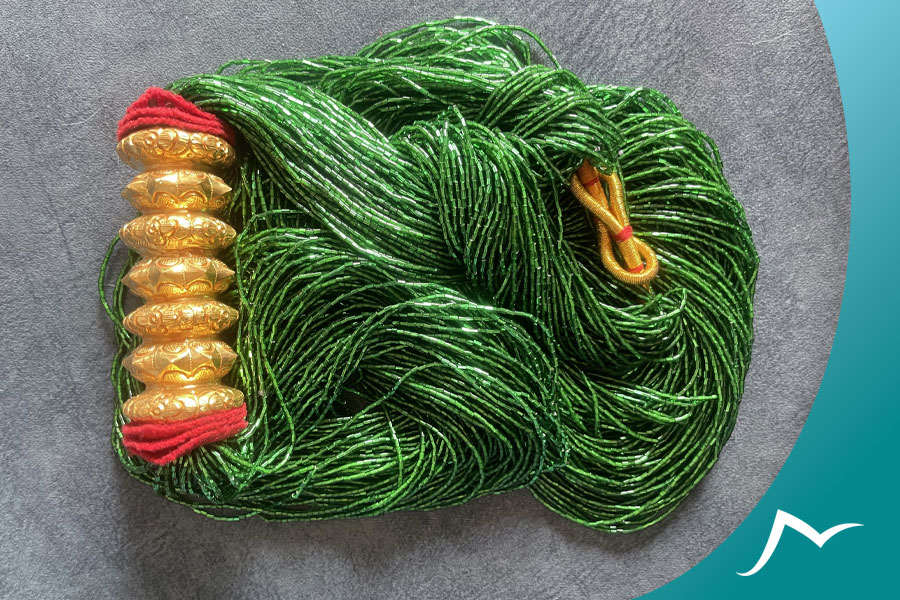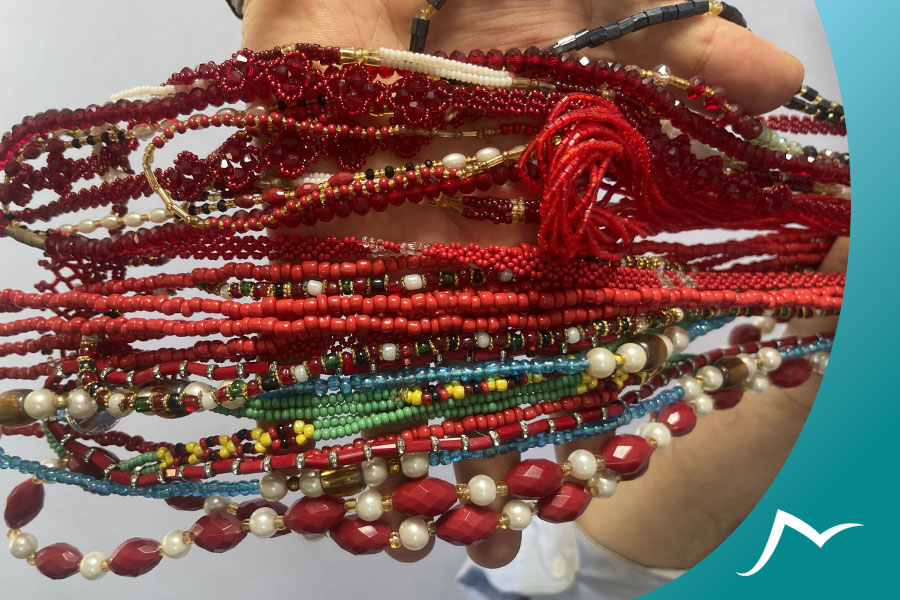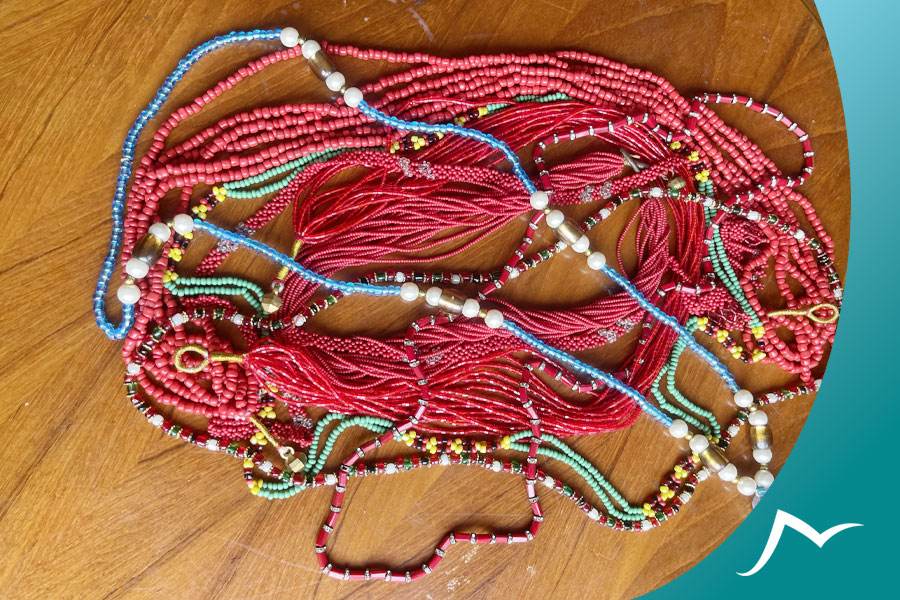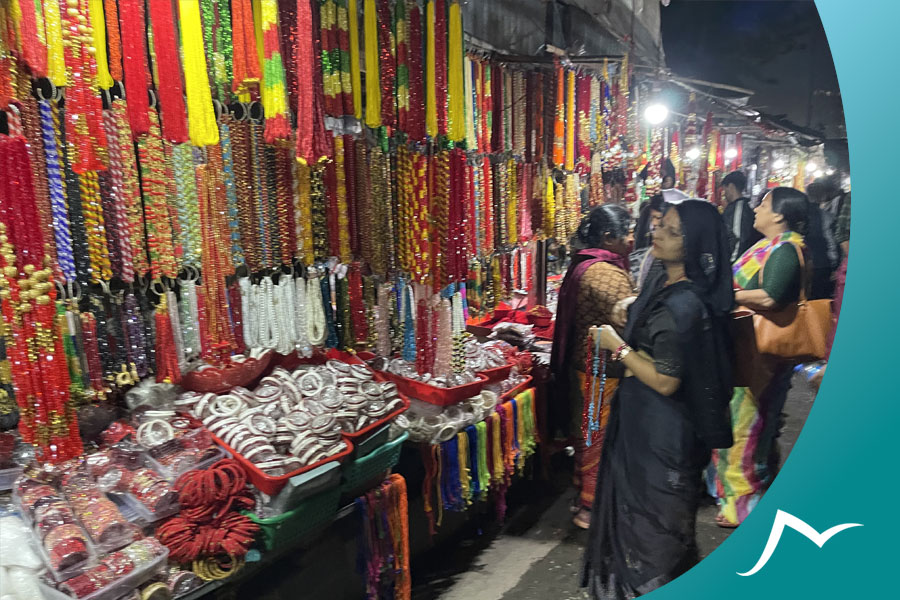Embark on a captivating journey into the world of glass bead and pote craftsmanship in Nepal. Delve into a realm where colors come alive and cultural heritage is intricately woven. Discover the mesmerizing artistry within each delicate bead, carrying stories of tradition and creativity. Whether you’re a collector, a jewelry enthusiast, or simply captivated by ancient crafts, this is your invitation to explore the enchanting allure of glass beads. From workshops that unlock the secrets of the craft to vibrant local markets showcasing masterpieces, immerse yourself in a world of enduring beauty and cultural significance. Let the artistry of glass beads and pote craftsmanship captivate your senses and ignite your imagination.
Historical Background
We must delve into its historical roots to truly appreciate the artistry of glass beads and pote craftsmanship in Nepal. The origins of this craft can be traced back through the annals of time, with influences from neighbouring regions shaping its evolution. Cultural exchange and artistic innovation have contributed to the unique styles and techniques that define Nepalese glass bead craftsmanship. By understanding its historical background, we gain a deeper appreciation for the artistry that continues to thrive today.
Materials and Tools
The creation of glass beads, especially pote, involves a careful selection of materials and the skilled utilization of tools. Various glass beads are used in pote crafting, each possessing distinct qualities and characteristics. From vibrant colors to intricate designs, these beads offer a wide range of possibilities for artisans to express their creativity. Additionally, traditional and modern tools ensure precision and finesse in every bead’s formation. Understanding the materials and tools involved allows us to grasp the intricacies of this art form and the craftsmanship it demands.

Techniques of Glass Bead Making
The art of creating glass beads is a meticulous and fascinating process. To truly appreciate the artistry involved, we must delve into the detailed steps of their creation. The process begins with carefully selecting raw materials, including high-quality glass rods and pigments. These materials are then heated to a molten state in a controlled environment, allowing the glass to be shaped and manipulated. Skilled artisans employ techniques such as lampworking or kiln-firing to create intricate designs, patterns, and textures on the beads. Each bead is a testament to the craftsmanship and expertise of the artisans who bring them to life. In recent times, contemporary approaches have also emerged, incorporating modern technologies and innovative methods into production. These advancements have expanded the possibilities and opened new horizons for glass bead makers, further enriching the artistry of their creations.
Pote Craftsmanship: Traditional and Contemporary Styles
Pote craftsmanship is a remarkable blend of tradition and innovation. Traditional designs and patterns form the backbone of this art form, rooted in Nepalese culture and history. These traditional styles often feature geometric shapes, floral motifs, and intricate beadwork. The craftsmanship reflects the cultural heritage and storytelling traditions of Nepal. Contemporary influences have seeped into pote crafting in recent years, introducing fresh perspectives and innovative designs. Modern elements, such as abstract patterns, fusion with other materials, and experimentation with colors, have breathed new life into this age-old art form. The juxtaposition of traditional and contemporary styles offers a captivating glimpse into the evolving artistry of pote craftsmanship.
Pote Making Process
Crafting a pote necklace is a labour-intensive process that demands precision and attention to detail. The journey begins with the selection of high-quality glass beads, which serve as the building blocks of the necklace. The beads are carefully sorted based on size, shape, and color, ensuring a harmonious composition. The pote maker then meticulously strings the beads together, following a predetermined pattern or design. Every bead is delicately positioned and secured, creating a symphony of colors and textures. The process requires patience and skill, as even the slightest deviation can impact the overall aesthetic of the necklace. From the initial design concept to the final knot, the pote making process is a testament to the dedication and craftsmanship of the artisans involved. The result is a stunning wearable art piece steeped in tradition and beauty.
Cultural Significance of Pote
Pote holds immense cultural significance in Nepalese society, particularly at weddings and other celebrations. In traditional Nepalese weddings, the bride adorns herself with a string of pote, believed to bring good luck and ward off evil spirits. These beads symbolize marital bliss, fertility, and prosperity. Beyond weddings, pote is also worn during religious ceremonies, festivals, and important milestones in life. Each pote design carries its symbolism and meaning, representing various aspects of Nepalese culture and spirituality. The cultural significance of pote is deeply ingrained in the fabric of Nepalese society, honouring tradition and fostering a sense of unity and identity.

The Role of Women in Pote Craftsmanship
The artistry of glass bead making, including pote craftsmanship, has historically been intertwined with the involvement of women. Women have played a crucial role in preserving and advancing this traditional craft. They have been the torchbearers of glass bead making for centuries, passing down their knowledge and skills from one generation to the next. Engaging in pote craftsmanship has provided women with economic empowerment and financial independence. By actively participating in this craft, women have showcased their creativity and contributed to their families livelihoods. The role of women in pote craftsmanship is a testament to their artistic abilities and their resilience and determination to thrive in a male-dominated field.
Challenges and Revival Efforts
While the artistry of glass bead craftsmanship, including pote, has a rich history in Nepal, it is not immune to contemporary challenges. In recent years, the craft has faced various obstacles threatening its survival. Factors such as the availability of cheaper mass-produced alternatives, changing consumer preferences, and limited market opportunities have posed significant challenges to glass bead artisans in Nepal. However, some dedicated initiatives and organizations are actively working towards preserving and promoting this craft. These efforts include creating awareness about the cultural importance of glass beads, organizing exhibitions and workshops, and supporting artisans with access to resources and marketing opportunities. Through these revival efforts, the artistry of glass bead craftsmanship, including pote, continues to find its place in the modern world, ensuring its preservation for future generations.
Market Demand and Global Reach
The artistry of glass beads, especially pote, has garnered domestic and international market demand. Nepal has a thriving market for pote, with locals embracing the cultural significance and aesthetic appeal of these handmade treasures. Additionally, there has been a growing global interest in Nepalese glass beads, with international buyers recognizing the exquisite craftsmanship and unique designs. Export opportunities have expanded, allowing Nepalese artisans to showcase their artistry globally. The increasing market demand and global reach of pote highlight the enduring appeal and timeless beauty of Nepalese glass bead craftsmanship.
Pote Craftsmanship Workshops and Tourism
Pote craftsmanship workshops and training programs have emerged as valuable platforms for preserving and promoting this traditional craft. These workshops allow aspiring artisans and enthusiasts to learn the intricate techniques involved in pote making. Skilled artisans serve as mentors, imparting their knowledge and expertise to the next generation. Moreover, incorporating pote craftsmanship into Nepal’s tourism industry has created immersive experiences for visitors. Travellers can now participate in hands-on workshops, witnessing firsthand the artistry that goes into creating these intricate beads. By combining craftsmanship with tourism, Nepal celebrates its cultural heritage while offering visitors a chance to engage with the artistry of pote.

Sustainability and Ethical Considerations
While the artistry of glass bead production brings beauty and cultural value, it is essential to consider its environmental and ethical implications. The production process of glass beads can have an environmental impact, particularly in energy consumption and waste generation. However, there is a growing consciousness within the industry to adopt sustainable practices. From sourcing eco-friendly materials to implementing efficient production methods, glass bead artisans are increasingly mindful of reducing their environmental footprint. Furthermore, fair trade practices have gained prominence, ensuring that artisans receive fair compensation for their work. By prioritizing sustainability and ethical considerations, the artistry of glass beads and pote craftsmanship can continue to flourish responsibly, preserving both culture and the environment.
The Beauty of Nepalese Glass Beads
Nepalese glass beads are renowned for their exquisite beauty and intricate craftsmanship. Each bead tells a story, reflecting the rich cultural heritage of Nepal. From the vibrant colors to the delicate patterns, these beads captivate the eye and evoke a sense of wonder. The skilled artisans invest countless hours creating each bead, ensuring meticulous attention to detail and precision. Whether it’s the dazzling pote adorning a bride on her wedding day or the ornate necklaces worn during festivals, Nepalese glass beads radiate a unique charm that speaks to the artistry and creativity of the craftsmen.
Preserving Tradition Through Apprenticeship
The artistry of glass bead craftsmanship in Nepal is safeguarded through the tradition of apprenticeship. Young artisans eager to learn the craft are taken under the wing of experienced masters, who pass down their knowledge and skills through hands-on training. The apprenticeship system ensures the continuity of the art form, as the wisdom and techniques of the older generation are imparted to the younger ones. This tradition not only preserves artistry but also fosters a sense of camaraderie and mentorship within the craft community, ensuring that the cultural heritage of glass bead craftsmanship thrives for generations to come.
Exploring the Symbolism of Pote Designs
Each pote design carries its symbolism, representing various aspects of Nepalese culture, spirituality, and identity. The intricate patterns and motifs adorning the beads hold deeper meanings woven into Nepalese traditions’ fabric. For example, certain designs may symbolize fertility and prosperity, while others represent protection and warding off negative energy. Exploring pote designs allows us to delve into the rich tapestry of Nepalese symbolism and understand the profound connections between the beads and the cultural heritage they embody.
The Evolution of Glass Bead Crafting Techniques
Glass bead crafting techniques in Nepal have evolved, influenced by cultural exchanges and technological advancements. Traditional methods, such as lampworking, have been passed down through generations, allowing artisans to create intricate designs by manipulating the molten glass. However, contemporary approaches have also emerged, integrating modern tools and technologies to enhance the precision and efficiency of the process. The evolution of techniques showcases Nepalese craftsmen’s adaptability and opens up new possibilities for innovative designs and expressions within the realm of glass bead craftsmanship.
Beyond Pote: Exploring Glass Bead Art in Nepal
While pote holds a prominent place in Nepalese glass bead craftsmanship, it is not the sole manifestation of the art form. Nepal boasts diverse glass bead art, including bracelets, earrings, and other ornamental pieces. These creations showcase the versatility of glass beads and the immense talent of Nepalese artisans. From intricate beadwork adorning clothing to delicate jewelry pieces, the artistry of glass beads in Nepal transcends boundaries and offers a glimpse into the creativity and skill that permeates the craft.
Pote Craftsmanship’s Influence on Jewelry Design
The artistry of pote craftsmanship in Nepal has profoundly influenced jewelry design, both within the country and beyond. The intricate patterns and vibrant colors of pote beads have inspired jewelry designers to incorporate these elements into their creations. Pote-inspired jewelry designs often feature beads as focal points or incorporate pote motifs into their intricate metalwork. These designs pay homage to the cultural heritage of pote craftsmanship while offering a contemporary twist. From statement necklaces to delicate earrings, the fusion of pote craftsmanship and jewelry design creates stunning pieces that celebrate the beauty and artistry of both mediums.

Pote Craftsmanship: A Cultural Legacy
Pote craftsmanship is more than just an art form; it is a cultural legacy passed down through generations. The techniques and traditions of pote crafting have been carefully preserved and transmitted from master artisans to their apprentices. This intergenerational transfer ensures that the craftsmanship remains authentic to its roots. By celebrating and embracing pote craftsmanship, Nepalese communities honor their cultural heritage and keep the flame of tradition alive. The legacy of pote craftsmanship is a testament to art’s resilience and enduring value in preserving cultural identity.
FAQs
What are pote beads made of?
Pote beads are typically made of high-quality glass rods that are melted and shaped into various forms.
What is the significance of wearing pote in Nepalese culture?
Wearing pote holds cultural significance in Nepalese weddings, celebrations, and religious ceremonies. They symbolize good luck, protection, and fertility.
Can I learn pote craftsmanship as a hobby?
Yes, there are workshops and training programs available where you can learn the art of pote craftsmanship as a hobby or for personal enjoyment.
Are pote beads only used in jewelry making?
While pote beads are commonly used in jewelry making, they are also incorporated into clothing, accessories, and decorative items.
Conclusion
In conclusion, the artistry of glass beads and pote craftsmanship in Nepal is a testament to this traditional craft’s creativity, skill, and cultural significance. The meticulous process of creating glass beads, the symbolic meaning behind pote designs, and the enduring legacy passed down through generations all contribute to the beauty and value of this art form. As we celebrate the artistry of pote craftsmanship, let us appreciate its cultural heritage, support its preservation, and continue exploring and embracing the enduring allure of glass bead crafting in our lives.
Pote craftsmanship in Nepal encompasses a rich history, cultural significance, and artistic value. It reflects the meticulous techniques and creativity of skilled artisans who transform glass beads into intricate masterpieces. Pote is special in Nepalese weddings, celebrations, and religious ceremonies, symbolizing prosperity, marital bliss, and protection. Despite challenges, pote craftsmanship remains resilient, adapting to modern influences while preserving its traditional essence. Its enduring beauty continues to captivate and inspire, showcasing Nepal’s timeless artistry and cultural heritage. By supporting and immersing ourselves in this craft, we honor its profound legacy and ensure its preservation for future generations to appreciate and cherish.



